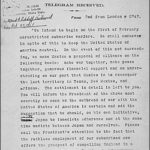Spectacular cases of involuntary commitment have found their way into newspapers and books and are interesting to read about, but in reality, many families were reluctant to commit their loved ones to an asylum. Authorities hoped that their magnificent buildings and varied amenities would reassure family qualms so that patients would be admitted before their cases became chronic.
In asylums’ early years, intervention at the beginning stages of mental illness often did lead to “cures,” or at least satisfactory outcomes. These successes helped families become more comfortable with the idea of commitment and gave them hope for their loved ones’ eventual cure.

Lunatic Asylum #2 (Missouri) Patients on an Afternoon Stroll, 1902, courtesy Glore Psychiatric Museum
However, some families were evidently intent on dumping an undesirable burden and never looking back. In an article about Tennessee’s Eastern State Asylum for the Insane, author Keith Townsend describes a man who entered the asylum in 1886. After some initial reports on his condition, records are silent for 59 years, until the man’s death at age 95 or 99. No one seemed to take an interest in him, nor did the administration of the asylum seem to consider that a different type of institution made more sense for such an elderly man.

Woodside Building, Eastern State State Hospital for the Insane, courtesy University of Tennessee Libraries






